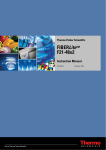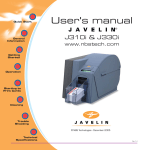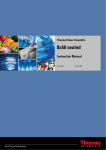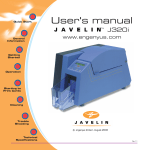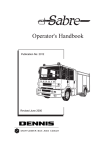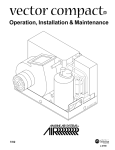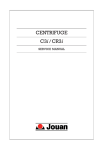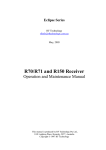Download SORVALL T3 Centrifuge Service Manual
Transcript
Sorvall T3 RT3 Service Manual 120V/230V Service Manual 11290099 page 1 of 44 Analyze • Detect • Measure • Control™ SORVALL T3 / RT3 Centrifuges SERVICE MANUAL 11290099 CAREFULLY READ THIS MANUAL AND THE OPERATING MANUAL BEFORE REPAIRING YOUR INSTRUMENT THIS DOCUMENT IS PROPERTY OF THERMO FISHER SCIENTIFIC it may not be duplicated or distributed without the owner's authorisation The validity of the guarantee is subject to the observation of the instructions and precautions described in this document Service Manual 11290099 page 2 of 44 REVISION STATUS INDEX DATE a 19/02/07 b 05/07/07 c 30/01/08 Service Manual 11290099 AMENDED PAGES NOTES Initial release P 40 Modification of cooling system part numbers Branding change page 3 of 44 WARRANTY THERMO FISHER SCIENTIFIC guarantees that this unit is free from defects in materials and workmanship when it leaves the factory and undertakes to replace or repair the unit if it proves defective in normal use or during service for a period of ONE YEAR from the delivery. Our liability under the guarantee is limited to repairing the defective unit or any part of the unit providing it is sent, postage paid, to an authorized service centre or the SAINT-HERBLAIN office. This guarantee is invalid if the unit is incorrectly used, poorly serviced or neglected, mis-used or accidentally damaged. There is no explicit guarantee other than as stated above. For further information, assistance or service : Technical Service Address North America: +1 866 984 3766 Europe: Austria +43 1 801 40 0 Belgium +32 2 482 30 30 Finland +358 9 329 100 France +33 2 28 03 20 00 or +33 1 6918 7777 Germany +49 6184 90 6940 or +49 6103 408 1012 Italy +39 02 95059 1 Netherlands +31 76 571 4440 Russia/CIS +7 095 225 11 15 Spain/Portugal +34 93 223 3154 Switzerland +41 1 454 12 12 UK/Ireland +44 870 609 9203 Asia: India +91 22 5542 9494 Japan +81 45 453 9220 China +86 21 6865 4588 or +86 10 5850 3588 Other Asian countries +852 2885 4613 Countries not listed: +49 6184 90 6940 or 33 2 28 03 20 00 Service Manual 11290099 page 4 of 44 CONTENTS 1. INTRODUCTION .................................................................................................................... 7 1.1. PURPOSE..................................................................................................................................... 7 1.2. PRESENTATION ........................................................................................................................ 7 SPECIFICATIONS................................................................................................................................... 8 1.2.1. 1.2.2. 1.2.3. 1.3. 2. 2.1. DESCRIPTION.......................................................................................................................... 10 2.2. COMPONENT LAY-OUT........................................................................................................ 10 2.3. MOTOR CONTROL PRINCIPLE.......................................................................................... 12 2.4. 2.4.1. 2.4.2. 2.4.3. 2.4.4. 2.4.5. 2.4.6. 2.4.7. Introduction ............................................................................................................................................12 The motor...............................................................................................................................................12 Power control .........................................................................................................................................13 ELECTRONICS - STRUCTURE............................................................................................. 15 Introduction ............................................................................................................................................15 Microprocessor + Power pcb..................................................................................................................15 Imbalance sensor....................................................................................................................................16 Tacho sensor...........................................................................................................................................16 Temperature sensor (RT3) .....................................................................................................................16 Refrigeration control board (RT3) .........................................................................................................16 Input - Output.......................................................................................................................................17 DIAGNOSTICS AND REPAIRS........................................................................................... 18 3.1. INTRODUCTION...................................................................................................................... 18 3.2. FUNCTIONAL TEST ............................................................................................................... 18 3.2.1. 3.2.2. 4. INSTALLATION PROCEDURE............................................................................................... 9 THEORY OF OPERATION .................................................................................................. 10 2.3.1. 2.3.2. 2.3.3. 3. Dimensions and weight ............................................................................................................................8 Electrical Specifications...........................................................................................................................8 Performance .............................................................................................................................................8 Eprom version ........................................................................................................................................18 Test mode ...............................................................................................................................................18 3.3. FAULT CODES ......................................................................................................................... 21 3.4. TROUBLESHOOTING CHART............................................................................................. 22 REPLACEMENT PROCEDURES ....................................................................................... 24 4.1. 4.1.1. 4.1.2. MOTOR REPLACEMENT ...................................................................................................... 24 VENTILATED model - T3 ....................................................................................................................24 Refrigerated model RT3........................................................................................................................26 4.2. IMBALANCE DETECTOR REPLACEMENT ..................................................................... 27 4.3. REPLACEMENT OF THE LID LOCK ASSEMBLY........................................................... 27 4.4. LID LOCK ASSEMBLY ELEMENT REPLACEMENT...................................................... 28 4.4.1. 4.4.2. 4.4.3. 4.5. 4.5.1. 4.5.2. 4.5.3. Lid lock microswitch replacement .........................................................................................................28 Lock solenoid microswitch replacement ................................................................................................28 Solenoid replacement .............................................................................................................................29 POWER SUPPLY RACK REPLACEMENT ......................................................................... 29 Dismounting...........................................................................................................................................29 Refitting .................................................................................................................................................29 Refrigeration board (RT3 ) replacement ................................................................................................29 Service Manual 11290099 page 5 of 44 CONTENTS 4.6. ELECTRONIC BOARD REPLACEMENT ........................................................................... 30 4.6.1. 4.6.2. Microprocessor + Power pcb..................................................................................................................30 Display board .........................................................................................................................................30 4.7. GAS SPRING REPLACEMENT ............................................................................................. 31 4.8. EPROM REPLACEMENT....................................................................................................... 32 4.9. LID REPLACEMENT .............................................................................................................. 32 4.10. REFRIGERATION SYSTEM REPAIRS (RT3) .................................................................... 33 4.10.1. 4.10.2. 4.11. 5. Motor checking........................................................................................................................... 34 SPARE PARTS....................................................................................................................... 35 5.1. T3 GENERAL SCHEMATIC ................................................................................................. 35 5.2. RT3 GENERAL SCHEMATIC............................................................................................... 36 5.3. MOTOR ...................................................................................................................................... 37 5.4. LOCK.......................................................................................................................................... 38 5.5. ELECTRONIC RACK .............................................................................................................. 39 5.5.1. 5.5.2. 6. Refrigeration SYSTEM replacement.................................................................................................33 Condenser components replacement .................................................................................................34 Rack T3 ..................................................................................................................................................39 Rack RT3 ..............................................................................................................................................39 5.6. FRONT PANEL ......................................................................................................................... 40 5.7. COOLING UNIT (RT3) ............................................................................................................ 41 WIRING DIAGRAMS............................................................................................................ 42 Service Manual 11290099 page 6 of 44 1. INTRODUCTION 1.1. PURPOSE This manual contains maintenance instructions intended for use by a qualified maintenance or service technician. It is organized to provide maintenance personnel with basic data on the theory of operation to assist in troubleshooting. Moreover, it outlines parts replacement and calibration procedures for putting the centrifuges back into service. Should a specific maintenance problem arise which is not covered in this manual, please ask the authorized service organization in your area for assistance, or contact our sales department : THERMO FISHER SCIENTIFIC 10 Rue Duguay Trouin 44807 SAINT HERBLAIN Tel : 33 (0)2 28 03 20 20 Fax : 33 (0)2 28 03 20 10 1.2. PRESENTATION The T3, RT3 (refrigerated) centrifuges are instruments designed for laboratory use. Using relative centrifuge force (RCF) allows elements of different density to be separated. The rotor is the main load ; a swing-out design allows a higher load than does an angle design. The larger the rotor diameter is, the higher the load can be and thus the slower the speed will be. The RCF is directly proportional to the radius of sedimentation and to the square of the speed. The gas used in the refrigeration system (RT3) is R130a, without CFC, recommended by the applicable directive for protection of the ozone layer. Sorvall T3 and Sorvall RT3 operator panel overlay. Service Manual 11290099 page 7 of 44 SPECIFICATIONS 1.2.1. DIMENSIONS AND WEIGHT Dimensions (H x W x D) Packed (H x W x D) Weight – uncrated / crated SORVALL T3 : 43 x 58 x 69 cm SORVALL T3 : 58 x 78 x 69 cm SORVALL T3 : 80 kg / 91 kg SORVALL RT3: 43 x 85 x 69 cm SORVALL RT3: 58 x 105 x 69 cm SORVALL RT3: 108 kg /121 kg 1.2.2. ELECTRICAL SPECIFICATIONS Mains supply 220/240 VAC 50 Hz SORVALL T3 75002385 SORVALL RT3 75002387 Mains supply 120 VAC 60 Hz SORVALL T3 75002386 SORVALL RT3 75002388 Max power SORVALL T3 : 1200 W SORVALL RT3 : 1500 W Average power SORVALL T3 : 700 W SORVALL RT3 : 1400 W Refrigeration SORVALL RT3 : 700 W 1.2.3. PERFORMANCE Max speed Swing-out : 4000 rpm (SORVALL T3) Swing-out : 4500 rpm (SORVALL RT3) Angle : 7800 rpm (SORVALL T3) Angle : 8000 rpm (SORVALL RT3) Max RCF Swing-out : 3800 x g (SORVALL T3) Swing-out : 4800 x g (SORVALL RT3) Angle : 9360 g (SORVALL T3) Angle : 9600 g (SORVALL RT3) Max capacity Swing-out : 4 x 750 ml Angle : 8 x 100 ml Display High visibility digital display Memory size 5 programs, direct access Program protection Recall key lock Speed Range Step Accuracy 500 to 8000 rpm 10 - 100 rpm ± 20 rpm Timer Range Step 30 sec to 99 min + hold position 30 sec to 1 min Acceleration rates 5 Braking rates 5 (from 1 tom 5) + 0 = brake cancel (coasting from 2000 rpm to 0 rpm) Temperature SORVALL RT3 Range -9°C to +40°C Step Accuracy 1°C ± 1,5°C Typical performance 4°C at 4500 rpm (4 x 750ml swing-out) 1°C at 7800 rpm (30 x 1,5 ml angle) Max density 1,2 g/cm3 Max energy 30000 J (CD2 rotor at 8000 rpm) Radius Range Step Service Manual 11290099 ± 1.5°C 64 to 178 mm 1 mm page 8 of 44 1.3. INSTALLATION PROCEDURE IMPORTANT: at least two people are required to lift the centrifuge from the palette and place it on the bench. Incorrect installation will affect safety and equipment performances. The machine must be installed in a dust and non corrosive environment. 1. The Bench top must be rigid, sufficiently strong and levelled. 2. 300 mm of free space gap must be left on each side of the machine to ensure the proper ventilation. The centrifuge could move as a result of rotor imbalance, rotor disruption or drive failure. To avoid dangerous consequences a safety envelope clearance around the unit must be respected. Service Manual 11290099 page 9 of 44 2. THEORY OF OPERATION 2.1. DESCRIPTION The microprocessor system which controls the SORVALL T3 and SORVALL RT3 centrifuges ensures the operation of the following major elements : - Management of the operating modes, - Generation of alternating current amplitude and frequency, - Adjustable components for the motor speed servo, - Management of the acceleration and braking profile/rates, - Management of the temperature regulation (SORVALL RT3), - Management of the safety devices : . Lid lock . Zero speed detection . Imbalance detection . Motor over temperature detection. - Management of fault diagnosis 2.2. COMPONENT LAY-OUT The input and control devices are located on the front panel and are comprised of a membrane keyboard and three digital displays. Everything is controlled by a 16 bit microprocessor. The control program of the centrifuge is stored in an EPROM. Data are conveyed into a dynamic RAM and are saved even when the power is down, thanks to an internal battery, which supplies power. Service Manual 11290099 page 10 of 44 Service Manual 11290099 page 11 of 44 2.3. MOTOR CONTROL PRINCIPLE 2.3.1. INTRODUCTION The SORVALL T3 / SORVALL RT3 family of centrifuges is fitted with an asynchronous 3 phase motor. During centrifugation, the microprocessor generates a system of sinusoidal 3 phase voltages variable in amplitude and frequencies. During the braking phase the energy from the rotating parts is commuted across a resistance. 2.3.2. THE MOTOR The motor is comprised of a 3 phase stator and a short-circuited rotor. When correctly powered, the stator creates a magnetic field rotating at the synchronised speed Ns : Ns = F/p F : supply frequency P : number of pairs of poles of the motor The rotating field generated in the motor induces e.m.f.'s. These e.m.f.'s produce currents in the short circuited rotor. These induced currents found in the magnetic field create forces opposed to those which induced them. It is the relative speed between the rotor and stator which is the cause of these induced currents, thus the forces will reduce this relative speed by driving the rotor at a speed close to that of the fields created at the stator. The difference (s) between the synchronised speed Ns and the actual speed N of the rotor is called the slippage. s = Ns - N Ns At a given frequency, the slippage value depends on the resisting torque (i.e. that of the rotor). Rotor Stator Service Manual 11290099 page 12 of 44 2.3.3. POWER CONTROL It is necessary to supply, from a single phase mains supply (230 V - 50 Hz or 120 V - 60 Hz), three variable tensions with amplitude and with frequency, dephased by 2π/3. E R A + C S T B 0 The voltage is rectified then filtered by C to supply the constant voltage +E. The value of the capacitor C is high. For a 230V – 50 Hz mains supply E = 230 √2 = 325 V C = 1000 µF / 400 V The 6 transistors act as switches (open or closed). These transistors commute at a fixed frequency (8 kHz). To affect the voltage at T we act upon the commands of the transistors a and b, b always being the opposite to a (a = closed, b = open). By changing the cyclic ratio (closed/open) we obtain a mean sinusoidal value so we are able to vary the amplitude and frequency. The pilot frequency must be elevated compared to the frequency of the generated sinusoidal voltage. The latter is around 400 Hz at 24000 r.p.m. (f pilot / f sin = 10 at max. speed). In the same way, the voltages at points R and S will be sinusoidal between OV and +E and dephased by 2π/3 between them. These 3 voltages are simple voltages varying between OV and +E. They are partly sinusoidal and partly on a baseline situated at +E/2. Thus the O of the sinusoidal voltage corresponds to 50 % of the cyclic ratio. The voltages applied to the rotor phases are the compound voltages VR-VS,VS-VT, VT-VR and will vary between +E and –E (0-(+E) = -E). Thus the voltages with amplitude close to that of the mains are reproduced at the motor terminals. Speed synchronisation is directly proportional to the frequency of the voltage supplied to the motor. Ns = fx 60 (for a 2pole motor). The motor rotates at a speed N below the speed Ns. Ns – N = SLIPPAGE (the slippage varies between 1 and 3 %). Ns Service Manual 11290099 page 13 of 44 To vary the speed, it is necessary to vary NS and thus the frequency of the voltage supplied to the motor. The torque characteristics will be translated on the speed axis. The supply voltage will vary from O to 4000 r.p.m. in order to keep the U/f ratio constant and not saturate the magnetic circuit. Couple Torque Couple résistant Vitesse Speed Service Manual 11290099 page 14 of 44 2.4. ELECTRONICS - STRUCTURE 2.4.1. INTRODUCTION The electronic part of the apparatus consists of two boards : the microprocessor + power pcb, where every function is located and the user interface pcb with display, and LEDs. The former is located inside the body of the machine, the second behind the front panel. The electronic imbalance sensor is located on the motor stabilizer and allows the detection of excessive imbalance due to the rotor loading. 2.4.2. MICROPROCESSOR + POWER PCB On the microprocessor + power pcb, 3 distinct zones can be identified, whose functions are described below. Each zone has its own independent power supply. ZONE 1 This zone includes the microprocessor, the EPROM containing the software and the non-volatile RAM containing the program parameters. The set of components in this zone is at the potential of the microprocessor : 5 VDC. ZONE 2 This zone ensures the conformity of the signal type coming from the different detectors before their arrival at the microcontroller via opto couplers. It also monitors the lid lock control and refrigeration group command. The power supply for this zone is 12 VDC. The different signals coming to this zone are : - Bowl temperature - Signal coming from the imbalance sensor - Tacho signal - Lid position signal - The motor over temperature and the lid solenoid control Service Manual 11290099 page 15 of 44 ZONE 3 WARNING : THIS ZONE IS AT MAINS VOLTAGE This zone, isolated from the microprocessor part by opto-couplers, is the electronic part related to the power in the system. This zone includes : - The 15 VDC power supply for the control electronics for this zone. - The control circuit of the 6 basic signals of the IGBT module. - The 3 PWM commands coming from the microcontroller. - The command of activation of the module of power coming from the micro-controller. - The brake GBT with the command which permits flow through the braking resistor. - The diode bridge which, from the mains, charge the capacitor of the continuous bus. - The relay which, controlled by the supply of power, then short circuits the resistance of the charge of the capacitors of the continuous bus a few moments after switch-on. - The module of 6 IGBTs and its heat sink which power the motor. 2.4.3. IMBALANCE SENSOR As described in the introduction, this sensor allows the detection of an excessive imbalance in the rotor loading. The device amplifies vibrations due to the imbalance and generates a signal beyond a preset threshold. After shaping, this signal is sent to the microprocessor for the safety devices. 2.4.4. TACHO SENSOR The tacho sensor is comprised of an optical sensor, which generates two pulses per revolution. 2.4.5. TEMPERATURE SENSOR (RT3) The sensor is a double thermistor. It delivers a signal proportional to the temperature. 2.4.6. REFRIGERATION CONTROL BOARD (RT3) The board controls the power signal to the refrigeration group. Service Manual 11290099 page 16 of 44 Imbalance detection 2.4.7. INPUT - OUTPUT Termal probe Tachy hall ST1 Towards display board Temp. motor Alim. 24 Switch electro Switch lock Electro Order goup Alim Sector power Alim face Diodes version 120V Alim Motor Contactor R Brake Service Manual 11290099 page 17 of 44 3. DIAGNOSTICS AND REPAIRS 3.1. INTRODUCTION The SORVALL T3 and SORVALL RT3 are equipped with a diagnostic menu in order to help locate possible breakdowns. The possible conditions of malfunction are communicated to the user by means of error codes on the display and buzzer alarms. 3.2. FUNCTIONAL TEST Certain functional tests can be done directly using the keyboard and display. These tests must only be undertaken by someone qualified to do so. They are protected by an access code. 3.2.1. EPROM VERSION The first message that appears when the machine is switched on remains active for a few seconds (machine set up). Display RPM Display Time Display Temp SORVALL T3 SORVALL RT3 M30 40 or 41 “FW Revision” M30r 80 or 81 “FW Revision” Note: Display Time – the second digit (0 or 1) indicates the position of jumper ST1 factory -selected. 3.2.2. TEST MODE This mode is accessible by using a combination of keys while the machine is setting up (at power ON). Press on the following two keys at the same time : Service Manual 11290099 • Acceleration profiles programming key • Braking profiles programming key page 18 of 44 Test 1 : Miscellaneous test 0 0 0 0 0 5 digit display : speed read T - 1 3 digit display : T-1 for Test 1 2 0 2 digit display : actual temperature Tachometer test : Turn the rotor by hand : the speed should appear on the 5 digit display. Lid solenoid test : Press on the key corresponding to program 2 to power and/or release the solenoid. Resetting of the 5 programs : Keep pressing on the key corresponding to program 4. Complete program resetting on RAM : Press simultaneously on the Δ speed programming key and the PULSE key to allow complete resetting of the machine when it is next switched on. - Press START to pass to the next test - Press STOP to leave the test mode Test 2 : Run linking This test safety used in the factory, starts a series of preset runs after having pressed the pulse key : C Y C L E - - 6 Run cycles of the selected program can be run with a one minute pause between each Press Δ and ∇ to change the number of runs from 1 to 99 Cycles won't start if cycles number is less than 3. During the run, when rotating, displays are the same as they would be outside the test mode. Between two runs (1 minute pause) displays are : C Y C L E 0 0 0 Reserved for factory testing 2 Next run number - Press START key to go to the following test - Press STOP key to exit from the test mode Service Manual 11290099 page 19 of 44 Test 3 : Statistical analysis S T A T S - - 0 Press Δ and ∇ to scroll on the 5 digit display 1 : running hours total (x 100) 2 : total number of runs 3 : number of hours above 5000 rpm 4 : number of runs above 5000 rpm - Press START key to go back to test 1 - Press STOP key to exit from the test mode Service Manual 11290099 page 20 of 44 3.3. FAULT CODES When certain faults are detected an audible alarm is switched on in addition to a code and a message. Depending on the fault, the machine stops automatically under the conditions indicated in the following table : Error code 01 Origin Incorrect speed measurement State of the centrifuge The rotor will brake to a stop. Lid opening is impossible till speed is zero and a 4 minutes- timeout is expired User’s action Wait for rotor to stop. Wait for the 4 minutes timeout. To erase the message , open the lid, turn the power switch off and turn the power switch on Press any keyboard button to erase this message. Note: if Error 01 has been detected and not cleared, as above described, the alarm reset is possible only after a safety time of 30 minutes 03 Power was interrupted during a run. At power off the rotor will coast to a stop. 04 Speed > 0 RPM at power ON The rotor will coast to a stop. CLOSE Lid Lid open at start The centrifuge doesn‘t start if the lid isn’t properly closed 06 Lid open in running mode The rotor will brake to a stop. IMBAL Imbalance. The rotor will brake to a stop. Wait for the centrifuge to stop. Press any keyboard button to erase this message. Verify that a balanced load is installed. Inspect the rotor and rearrange the tubes, or add additional tubes with fluid to balance the rotor. 08 Motor Overtemperature OR Lid lock error The rotor will brake to a stop. Wait for the centrifuge to stop. Press any keyboard button to erase this message. Wait for motor cooling down. 09 Chamber OverTemperature The unit displays this code if the measured temperature exceeds 50°C, at any time during the run. The rotor will brake to a stop. Refrigeration Failure (Refrigerated only) Wait for the centrifuge to stop. Press any keyboard button to erase this message. Verify the operating condition. 11 Electronic failure All controls are disabled To erase the message turn the power switch off and turn the power switch on Wait for rotor to stop. Press any keyboard button to erase this message. Press any keyboard button to erase this message. Close the lid and press “START“ Wait for the centrifuge to stop. Press any keyboard button to erase this message. Note: All error indications can be cleared by turn the power switch off and turn the power switch on. Service Manual 11290099 page 21 of 44 3.4. TROUBLESHOOTING CHART Preliminary remark: when a default is reported, first carry out the appropriate functional test, then refer to the troubleshooting chart below. Problem 1) No control active and no indicator lights ON. Possible cause Remedy No voltage being applied to the centrifuge. Check mains outlet and power cable. Fuses blown Check for short-circuits. Check the absence of short circuits with an ohm-meter (mains cable disconnected). Reset the circuit breaker (replace as required). Switching of the line differential Check the insulation between the mains and the earth of the centrifuge. Short circuit at the power level. Disconnect the mains wires arriving at the μP p.c.b. If there is still a short circuit at this level change the μP board or the capacitor. Check the connections. Short circuit on the +5V. Check the presence of +5V on the mother board with the board disconnected from the display board. If +5V is present change the display board. If +5V is absent check the resistance between the μP board earth and +5V with the ohm-meter. If the resistance is zero, change the μP board,. If not zero, carry out the following test. Absence of low voltage on the μP board. Check the presence of alternating voltages on the transformer output. Faulty display. Check the cables/connectors linking the μP board to the display card. 2) All controls inoperative. The display is lit up without information. Faulty microprocessor board. Check the cables/connectors to the display. Check the correct positioning : - of the EPROM on the μP board. – of the microprocessor on the μP board. 3) Compressor test incorrect (RT3). Control fault. Check the voltage applied to the compressor terminals. If not apparent or if incorrect, change the control board. If no effect, change the mother board. If correct (230 or 120 V according to the version) change the condenser and/or the compressor start-up relay. If no effect the compressor coils. Faulty compressor or its accessories. Service Manual 11290099 page 22 of 44 Problem 4) Error 08 Possible cause Control fault. Check the voltage applied to the solenoid terminals. If not apparent or incorrect (far from 24 VDC) change the mother board or the transformer. Faulty solenoid. If the voltage is correct, change the solenoid. Faulty lock solenoid microswitch Check/adjust or replace the microswitch which detects the solenoid position. Faulty Thermo-switch Wait the motor to cool down and check the continuity of the sensor Faulty motor Check motor (see section 4.12) Faulty tacho. Check the presence of a signal at the input to the mother board (with an oscilloscope or DC voltmeter). Pulses should appear every 12 sec. If absent or incorrect, change the tacho. Faulty μP board. If the pulses are correct, change the μP board. Failure of the motor bearings. Check by hand that the motor turns freely. Imbalanced load not detected Check the good state of the sensor. Defective shock absorbers on motor. Change shock absorbers. Failure of the motor bearings. Check by hand that the motor turns freely and without noise or abnormal friction. If necessary change the motor. μP board power bridge broken down. Change the μP board. Defective start switch. Change the keyboard. Main relay not energised. Adjust lid switches. If the cooling unit runs permanently and the bowl temperature is always too high, look for an air leakage at the lid air tightness or a fluid leakage. Adjust the lid. Call a refrigeration engineer. Lid lock solenoid test incorrect Motor Overtemperature 5) Tacho test incorrect. 6) Vibrations 7) Starting impossible. All controls and display are operational. 8) The temperature performances are not correct. (Error09) Remedy If the display doesn't correspond to the Change the probe. real temperature, there is a reading Change the PC board. problem. 9) Lid unlocked when starting or during rotation (Error 06) Service Manual 11290099 Faulty microswitches Check or change microswitches. page 23 of 44 4. REPLACEMENT PROCEDURES CAUTION : DISCONNECT THE MAINS POWER LEAD TO THE CENTRIFUGE BEFORE ALL REPLACEMENT PROCEDURES ! Replacement of spare parts and adjustment are done using standard tools by a maintenance engineer specialised in laboratory equipment. As a guide, a list is given in the appendix. If, for a particular reason, any other tools are required, these are clearly specified in the relevant chapter. 4.1. MOTOR REPLACEMENT 4.1.1. VENTILATED MODEL - T3 Dismounting - Remove the front panel (1) by unscrewing the screws and disconnect the power switch, the flat cable, the display supply and the front panel ground cable. Lift the bowl seal and unscrew the three press screws of the chamber. - Remove the bowl seal (2). - Lift and remove the bowl. - Disconnect the connectors from the motor (J14), the tacho sensor (J4), the imbalance sensor (J7), the microprocessor + power pcb and the thermoswitch connection. - Lay the centrifuge on the rear side. Remove the grid. - Unscrew the 3 screws, then turn the motor body (Fig 2). - Turn the engine 1/6 of a turn. - Remove it (Fig. 3). Refitting Carry out the above operations in the reverse order. WARNING: SHOCK ABSORBERS NOT TO BE DRILLED DURING THE REASSEMBLY Fig. 1 Service Manual 11290099 Fig. 2 page 24 of 44 Fig. 3 Service Manual 11290099 page 25 of 44 4.1.2. REFRIGERATED MODEL RT3 Dismounting - Remove the front panel by unscrewing the screws and disconnect the power switch, the flat cable, the display supply and the front panel ground cable. - Remove the Panduit connector from the motor (J14) and from the tacho sensor (J4) of the motor board (see connectors) and the thermoswitch connection. - Remove the seal in the base of the bowl. (Fig. 1). - Lay the centrifuge on the rear side. Remove the grid. - Unscrew the 3 screws, then turn the motor body (Fig 2). - Turn the engine 1/6 of a turn. - Remove it (Fig. 3). Refitting - Carry out the above operations in the reverse order. WARNING: SHOCK ABSORBERS NOT TO BE DRILLED DURING THE REASSEMBLY Service Manual 11290099 page 26 of 44 4.2. IMBALANCE DETECTOR REPLACEMENT Dismounting - Remove the front panel by unscrewing the screws and disconnecting the power switch, the flat cable, the display supply and the front panel ground cable. - Remove the rack disconnecting all the electrical connections. - The sensor is located on the motor stabilizer. - Unscrew the 2 screws and remove the sensor from the stabilizer. Disconnect J4. Refitting - Carry out the above operations in the reverse order. 4.3. REPLACEMENT OF THE LID LOCK ASSEMBLY Dismounting - Open the lid. - Remove the front panel by unscrewing the screws and disconnecting the power switch, the flat cable, the display supply and the front panel ground cable. - Disconnect the lid lock assembly of the microprocessor + power pcb by disconnecting the J8 and J10 connectors. - Unscrew the 2 nuts on the body of the instrument. - Remove the lid lock assembly. Refitting - Remount the lid lock assembly on the body, in alignment with the fixing points and keeping it in position thanks to the nuts. - Check the correct position of the lock to ensure a convenient lid closing. - Screw down the nuts to the body of the instrument. - Reconnect the electrical connectors. - Remount the front panel. Lid solenoid Microswitch Back face 2 microswitch Front face Service Manual 11290099 page 27 of 44 4.4. LID LOCK ASSEMBLY ELEMENT REPLACEMENT 4.4.1. LID LOCK MICROSWITCH REPLACEMENT Dismounting - Disconnect the microswitch - Unscrew the mounting bolts (2) and dismount the microswitch. Refitting - Carry out the above operations in the reverse order. Ensure that the microswitch rod does not hit the cam when the lid is open to avoid false alarm. 4.4.2. LOCK SOLENOID MICROSWITCH REPLACEMENT Dismounting - Dismount the lock assembly. - Disconnect the microswitch. - Unscrew the screw located on the diagonal. Keep the screw. Refitting - Carry out the above operations in the reverse order. WARNING : THE MICROSWITCH ROD MUST BE SHAPED TO WORK PROPERLY AND TO GIVE A GOOD STROKE TO THE SOLENOID MOBILE CORE Service Manual 11290099 page 28 of 44 4.4.3. SOLENOID REPLACEMENT Dismounting - Dismount the lock assembly. - Disconnect the solenoid by cutting the 2 wires at the level of the sleeves. - Supporting the solenoid, unscrew the screws on the back of the lid lock assembly panel. Refitting - Carry out the above operations in the reverse order. - Ensure that the stroke of the solenoid mobile core is unimpeded. - Re-solder the 2 wires to the solenoid, not forgetting to fit the insulating sleeves. Nota : Solenoid microswitch and lid lock microswitch replacement can be performed without having to remove the whole lid lock assembly. 4.5. POWER SUPPLY RACK REPLACEMENT 4.5.1. DISMOUNTING - Remove the front panel Unscrew the screw situated in front of the transformer. Remove all electrical connections. Remove the rack. 4.5.2. REFITTING - Carry out the above operation in the reverse order. Respect the wiring diagram. 4.5.3. REFRIGERATION BOARD (RT3 ) REPLACEMENT Dismounting - Disconnect the board. - Remove the board from the rack unscrewing the 2 screws (1). Refitting - Carry out the above operations in the reverse order. (1) (1) Service Manual 11290099 page 29 of 44 4.6. ELECTRONIC BOARD REPLACEMENT 4.6.1. MICROPROCESSOR + POWER PCB Dismounting - Remove the front panel. - Disconnect all cables from the board. - Unscrew the 5 screws holding the board ; one in each corner and one in the middle of the board. Remove the board. Refitting - Carry out the above operations in the reverse order, and do not forget to place the insulation sheet between the board and its support. 4.6.2. DISPLAY BOARD Dismounting - Remove the front panel - The board is located behind the front panel - Disconnect all cables from the board. - Unscrew the holding nuts and remove the board. Refitting - Carry out the above operations in the reverse order. Service Manual 11290099 page 30 of 44 4.7. GAS SPRING REPLACEMENT Gas spring replacement - Open the lid. Open the rear panel. Remove the screw located at the bottom of the gas spring. Remove the pin which joins the gas spring to the lid. Remove the gas spring. Refitting - Carry out the above operations in the reverse order. - Check the correct operation of the lid. Service Manual 11290099 page 31 of 44 4.8. EPROM REPLACEMENT WARNING : TO EXTRACT THE EPROM, USE A PROPER EXTRACTOR AND NOT ANY TOOL THAT COULD DAMAGE THE EPROM AND ITS SOCKET ! WARNING : DURING THE REPLACEMENT? MAINTAIN THE EPROM PARALLEL TO ITS SOCKET ! Extraction - Remove the front panel. To replace the EPROM, it is not necessary to remove the microprocessor + power PCB from its support. Extract the EPROM. Insertion - See the adjacent figure. WARNING : INSERT THE NEW EPROM WITH THE NOTCH TOWARDS THE MICROPRESSOR. - Execute the necessary calibration as explained in chapter 5. 4.9. LID REPLACEMENT - Open the lid. Extract the pin which binds the gas spring. Unscrew the 4 screws which bind the lid to the hinge. Remove the lid. Service Manual 11290099 page 32 of 44 4.10. REFRIGERATION SYSTEM REPAIRS (RT3) 4.10.1. REFRIGERATION SYSTEM REPLACEMENT Dismounting Referring to procedure already described and to the following figure : - Disconnect every cable. - Remove the lid. - Remove the front panel. - Remove the rack. - Remove the body and the rear panel. - Now, the centrifuge walls are separated from the body. - The refrigeration system remains fixed only to the body. Refitting - Carry out the above operations in the reverse order. Service Manual 11290099 page 33 of 44 4.10.2. CONDENSER COMPONENTS REPLACEMENT 4.11. Access the refrigeration group as described above. The condenser is in one block. Dismount it lifting and shifting the motor fan block. Separate the different parts. MOTOR CHECKING To check the motor electrical circuit integrity, continuity between phases has to be checked. As there are three wires, such a measurement has to be carried out alternately, at the terminals of two of them, choosing the third one as common. The two resistance values obtained refer to two successive phases (as the state circuit is star-configured). Check that : 1. The two values are identical (allowable difference ± 0,2 Ω); 2. The two values are not lower than 3,5 Ω (± 0,2 Ω); 3. There is no discontinuity. If there is no conformity to condition 1, the motor can run erratically. If there is no conformity to condition 2, the motor can run irregularity with over heating. If there is no conformity to condition 3, the motor cannot run. Service Manual 11290099 page 34 of 44 5. SPARE PARTS 5.1. T3 GENERAL SCHEMATIC Mark Reference 1 86000287 Breaker for 230 V models 1 1 86001434 Breaker for 120 V models 1 2 11250238 Overlay – Sorvall T3 1 3 26962008 Gas spring 2 4 25439072 Motor / bowl seal 1 5 25437049 Lid / bowl seal 1 6 85241270 Lid hinge 2 7 26566011 Rubber foot 4 8 11250227 Lid assembly Sorvall T3 1 9 85210884 Inner plastic lid 1 Service Manual 11290099 Description Qty page 35 of 44 5.2. RT3 GENERAL SCHEMATIC Mark Reference 1 86000287 Breaker for 230 V models 1 86001434 Breaker for 120 V models 1 2 11250239 Overlay – Sorvall RT3 1 3 26962008 Gas spring 2 4 25439072 Motor / bowl seal 1 5 25437049 Lid / bowl seal 1 6 85241270 Lid hinge 2 7 26566011 Rubber foot 4 8 11250228 Lid assembly for SORVALL RT3 1 9 85210923 Inner plastic Lid for SORVALL RT3 1 Service Manual 11290099 Description Qty page 36 of 44 5.3. MOTOR f Mark Reference All Models Description Qty 11250241 Motor kit (includes shock absorbers) 1 1 26007026 Shock absorber (1 piece) 3 2 85480878 Imbalance detector 1 3 89003554 Speed sensor 1 4 20904430 Collect chuck 1 Service Manual 11290099 page 37 of 44 5.4. LOCK Mark Reference All Models Description Qty 89002889 Complete lock 1 1 89000309 Lid solenoid (without switch) 1 2 26487030 Micro switch (without lever) 1 26461053 Flat lever 1 86001406 Safety micro switch 2 3 Service Manual 11290099 page 38 of 44 5.5. ELECTRONIC RACK f i c e g 5.5.1. RACK T3 Mark 1 2 3 4 5 6 Reference 230 V Reference 120 V 89002891 11250225 86004585 26387034 86004803 -86001432 85481427 89002892 11250225 86004586 26387045 39903078 86004598 86001432 85481431 d Description Main PCB SORVALL T3 Programmed EPROM Relay Fuse Transformer Power bridge Braking resistor Complete electronic rack h Qty 1 1 1 1 1 1 1 1 5.5.2. RACK RT3 Mark 1 2 3 4 5 6 7 Reference 230 V Reference 120 V 89002893 11250226 86004585 26387034 86004803 -26001432 89002899 85481426 Service Manual 11290099 89002894 11250226 86004586 26387045 39903078 86004598 26001432 89002899 85481430 Description Main PCB SORVALL RT3 Programmed EPROM Relay Fuse Transformer Power bridge Braking resistor Cooling control PC board Complete rack SORVALL RT3 Qty 1 1 1 1 1 1 1 1 1 page 39 of 44 5.6. FRONT PANEL c Mark Reference 1 89003600 Display PCB “packed” - MEGAFUGE 11/30/T1/T3 1 1 89003601 Display PCB “packed” - MEGAFUGE 11R/30R/RT1/RT3 1 Service Manual 11290099 Description Qty page 40 of 44 5.7. COOLING UNIT (RT3) g d e f c Mark Reference 230 V Reference 120 V Description Qty 1 89003560 89003561 Compressor 1 2 89003562 89003562 Condensor 1 3 89003563 89003563 Fan 1 4 89003564 89003565 Motor + stand (without fan) 1 5 86001274 86001274 Temperature probe assy 1 Service Manual 11290099 page 41 of 44 6. WIRING DIAGRAMS Service Manual 11290099 page 42 of 44 Service Manual 11290099 page 43 of 44 Service Manual 11290099 page 44 of 44












































